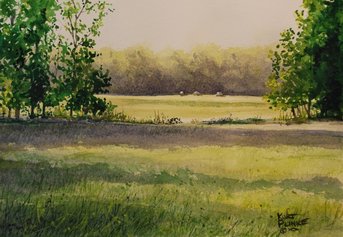| Kurt Plinke, Artist and Naturalist |
Between the Waters
life, Art and The Nature of things Between the Atlantic and the Chesapeake
Because of the warmer weather and the return of the small woodland birds, my thoughts have gone back to painting wildlife, especially the little jewel-like birds just returning from the south. Warblers often have brilliant flashing glimmers of golden yellow, and are fun to bring to life on paper. In fact, warblers are so much fun to draw and paint that I've made it the next workshop here at the studio. This workshop will be a little different. While we'll still share lunch, the first thing we will do is take a little walk. Actually, it will be more of a stroll, as we walk down the old dirt road by the studio, looking for warblers and plants to use as subject matter. Sketching as we walk, we'll decide together the kind of warbler we will paint. I can't wait to see what the group settles on... will it be a subtly colored Ovenbird, a pretty Pine Warbler, or something even brighter, like a Blackburnian Warbler? I guess we'll find out together. To sign up for the May 20th watercolor workshop, call the studio at (410) 200-1743 or email to reserve a chair at [email protected].
I especially love the challenge of trying new things as I paint. For so many years I spent my time in the studio painting things that I knew so well... a cardinal, a bluebird or some other animal. As I continue to paint, I want more and more to try new things and develop new ways to portray the world that I see. I think that this is why plein air has such an appeal, especially in warm weather. The chance to stand somewhere, look around, and create the feeling of the effects of light, shadow and texture in what I see appeals to me. Doing this as God's sun shines down on me just makes it better. Waxing... wax and watercolors just don't mix, right? I mean, putting wax on paper just creates a resist, a place on the surface where paint always refuses to adhere. Watercolorists are extremely cautious about waxes, oils and the like. Even having a tiny bit of wax or oil on your fingers and touching a piece of white paper ruins it for painting. So why talk about wax with watercolors? I'm experimenting right now to see if I can answer that question. A while back, I began to wonder if there was a way to paint with watercolors, but not frame the finished work under glass and surrounded by mats. Watercolors have been presented this way for close to a thousand years... glass to shield the watercolor from moisture in the air, and mats to protect the painting from moisture condensing on the inside surface of the glass. Artists using acrylic, oil and encaustic mediums don't worry so much about these problems. And I've envied them, but love water-based mediums so much that I don't want to change right now. The only time I came close was when I was painting a lot with egg tempera. With that medium, there is no need to protect the finished work, except to polish it. It seems strange, but pigment, water and egg yolk make a very durable medium. I began painting with egg tempera on a surface called Claybord, made by Ampersand.  Claybord is a piece of masonite, coated with a baked surface of hard white clay. Eventually, I tried using watercolors on the same surface. A little difficult at first, I grew to like using Claybord with watercolors. The paints lift very easily, meaning that pigment can be removed completely with a simple brush stroke. When the painting was finished, I used varnish to seal the surface. This worked, but only on days with low humidity (not a regular thing on the Eastern Shore). Then, the other day, I found an artist who mounted this finished watercolors (on paper), to a rigid surface. When the paper was secure to the surface, He used oil painter's wax to seal and protect the surface. When finished, the wax is polished and hardens, creating a durable protective layer. I tried it, and found that I like the results. Finally, watercolors that don't need glass. Right now I've only tried this process a couple of times. But I like the end product. The wax adds a warm glow to the painting, much like an oil painting that was glazed with a series of thin layers of almost transparent paint, and then varnished. The colors are richer and deeper. But best of all, the paintings are not surrounded by mats and glass. I know I'll be trying this some more.
0 Comments
Leave a Reply. |
What's News?Kurt Plinke: About Life, Art and the Nature of Things on the Eastern ShoreI write about things I've noticed, places I've been, plans I've made and paintings I've finished or am thinking about. Archives
February 2020
See recent naturalist observations I have posted on iNaturalist:
|
|
Sewell Mills Studio & Gallery
14210 Draper's Mill Road Greensboro, MD 21639 (410) 200-1743 [email protected] |
Rights to all images on this website, created by Kurt Plinke, remain the property of Kurt Plinke. Copying or use of these images is permissible only following written permission from Kurt Plinke. To use images for any purpose, contact [email protected] for permission.




